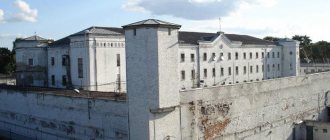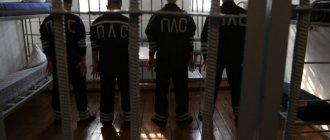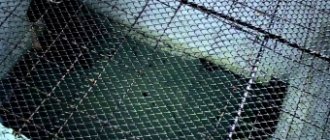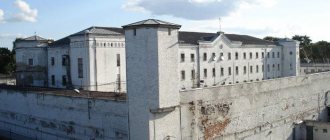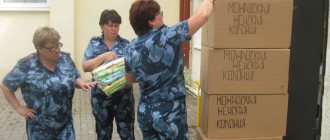Author: Natalya
15 August 2022 09:29
Tags: colonies, life imprisonment, prison terms
94860
27
According to the Federal Penitentiary Service, as of May 1, 2015, 1,914 people are serving life sentences in Russian correctional colonies. About a hundred more are serving a 25-year sentence instead of the death penalty, which was imposed before the moratorium but was not carried out. In the 1990s there were much more of them, but over the years many died in the colonies. In Russia, life-sentenced prisoners are held in five specialized institutions, each of which has a very romantic name.
0
See all photos in the gallery
Just like those sentenced to life: although there are no official statistics on mortality among them in open sources, according to unofficial data (such figures are given on forums for relatives of “inmates”), the average life expectancy of prisoners does not exceed 5-7 years. Remember the explosion of violent deaths after shootings first stopped in 1996? However, those who have at least somehow encountered places where life sentences are served in Russia unanimously declare that such punishment, as it occurs in our country, is much worse than a bullet in the back of the head. Of course, the issue is controversial, but let's look at how and where those sentenced to life imprisonment serve their sentences. Maybe SUCH a life, multiplied by the understanding that THIS IS FOREVER, is really harder than momentary pain and non-existence? Maybe this is what redemption should be like?
“VOLOGODA PYATAK” (Ognenny Island, Belozersky district, Vologda region).
0
×
0
0
Special regime correctional institution for life-sentenced persons FBU IK 5 (old name OE 256/5) “Vologda Pyatak” of the Federal Penitentiary Service of Russia for the Vologda Region. The standard occupancy is 505 places, including a general security section for 55 places (household service unit). Located in the Vologda region, Belozersky district, Ognenny Island, village. Novoozero, p/o K. Liebknecht. The colony on Ognenny Island in the Belozersky district is called “Vologda Pyatak” - after the number of the institution. “Vologda Pyatak” is located in the expropriated Kirillo-Novoezersky Monastery on Lake Novy (Fiery Island) near the city of Belozersk, in the Belozersky district of the Vologda region. After the October Revolution of 1917, the monastery was turned into a prison for “enemies of the revolution.” In the 1930s and 1940s, it was a colony for political prisoners in the Gulag system. In 1938, Novoyezerskaya ITK-14 was located here, after the war ITK-6, LO-17, which in the fifties was reorganized into a maximum security camp. In 1956, Penitentiary Colony No. 17 established a strict regime for men convicted for the first time of banditry and murder. In 1994, for the first time in the Vologda region and in Russia, a correctional colony was created on its basis with a new type of criminal punishment - life imprisonment. “Pyatak” was not chosen by chance. Only one road leads to the powerful thick walls of the monastery - a wooden bridge across the lake, with strong bars on the windows. It is almost impossible to escape from here. The first convicts were brought in in the spring of 1994 by convoy from Tambov. There were about 20 of them. Today, on Fire Island there are 192 prisoners sentenced to life imprisonment, as well as convicts for whom the death penalty was commuted to life imprisonment by way of pardon. In 1997, the monastery became a prison exclusively for prisoners serving life sentences. After the introduction of a moratorium on the execution of death sentences in Russia in 1996, these sentences began to automatically mean life imprisonment. The regime, level of isolation and security of the colony can be called one of the toughest places of detention in Russia. Criminals are kept here in conditions provided for special regime cell-type colonies with additional restrictions and increased requirements. The local “inmates”: - are kept in cells of two people; - always wear clothes only of a specially established type; - while walking, taking a bath, going to the toilet, etc. any contacts between convicts from different cells are excluded; - all actions are carried out only with the permission and at the command of the warden (junior inspector), any event takes place under the supervision of at least three employees (despite the fact that mass events with the participation of convicts - sports competitions, film screenings, school and vocational training - are not held at all); — only short-term visits lasting a few hours are provided, long-term personal visits are prohibited; — in the cells, convicts do not have the right to lie down during the day. They don’t even sit down on the bed, every time they are taken out of the cell they are subjected to a thorough search, the cells are also searched daily; — to events related to leaving the cell, convicts are accompanied in handcuffs. . The convicts are busy sewing mittens, and even this process takes place in special working cells for only two people. Famous "inmates": Gaitukaev Lom-Ali Akhmedievich - organizer of the murder of Anna Politkovskaya (2014 - lifelong). Shivkoplyas Vasily Sergeevich is a member of Alexander Borovkov’s gang. Killed 15 people (2003 - lifelong). Khubiev Arasul - organizer of the explosion in Mineralnye Vody (2002 - lifelong).
Liability for fraud
Every year, Russian courts sentence over 25,000 convicts to various penalties for fraud. Not all of them, of course, go to prison. And those who have not passed this cup spend different periods of time in places not so distant.
This entire flow is regulated by Article 159 of the Criminal Code in seven parts plus five additional articles.
The main article differentiates liability by type of fraud. The latter, in turn, are distributed according to the nature of the circumstances. Among them:
- the number of accomplices and their prior conspiracy;
- large or especially large amount of damage caused;
- selfish use of official position or own business;
- the onset of particularly significant consequences.
Additional articles separately address fraudulent activities in certain areas. Among them: payments from the budget and issuing loans, Internet and computer technology, electronic payments and insurance.
“POLARY OWL” (Kharp village, Yamalo-Nenets Autonomous Okrug).
0
0
0
Correctional institution FBU IK-18 (old name OG 98/18) of the Federal Penitentiary Service of the Russian Federation for the Yamal-Nenets Autonomous Okrug “Polar Owl” is a special regime colony with a strict section. 400 people are serving life sentences. To serve their sentences, they send here mainly serial killers, repeat offenders, and other especially dangerous state criminals who have committed more than one particularly serious and cruel crime. The capacity limit for special regime penal colony No. 18 for holding those sentenced to life imprisonment is 1,014 places, including a high-security section for 450 places and a colony-settlement section for 100 places. The colony is geographically located in the urban-type village of Kharp (from the Khantean language - “Northern Lights”) of the Yamalo-Nenets Autonomous Okrug, Tyumen Region. Address: 629420, Yamalo-Nenets Autonomous Okrug, Priuralsky district, pos. Kharp, tel.: +7 (34948) 7-26-40, 7-29-73. Geographically, the village is located beyond the Arctic Circle on the border of the tundra and the Northern Urals. The village is located in a picturesque place, in a geographical zone called the Polar Urals, surrounded by mountains, on the banks of the Sob River. The buildings inside the zone are in very poor condition, but the village, on the contrary, looks quite decent. There are also five-story brick houses and cottages. The population is about 7 thousand people. The nearest city is Labytnangi. It is located 1920 kilometers from Moscow. You can get to Kharp by train (2 days on the way from Moscow) or by plane (3 hours flight from Moscow to the airport in Salekhard, then by passing vehicles to the crossing, from where the so-called “air cushion” follows through the Ob River to the village of Labytnangi » (in winter) or ferry (after the ice has completely disappeared), and from Labytnangi to Kharp - by passing car. Climatic conditions are quite severe - 5 months a year (from October to February), the average temperature is about - 40 ° C, the rest of the time from - 10° to -30°, ice melts from rivers and lakes at the end of May, summer lasts only one month - July. The village of Kharp is a regime village, formed in 1961 during the construction of Stalin's construction site No. 501. The village began as a camp for prisoners who built a railway. Subsequently, the camp was transformed into a special regime colony for especially dangerous repeat offenders. A correctional colony for those sentenced to life imprisonment - FBU IK-18 with the unofficial name "Polar Owl" (on the territory of the colony there is a monument to an owl, the wingspan of which is more similar to the imperial Orla) is the most geographically remote in Russia. The conditions for serving the sentence are no different from those above in the “Vologda Pyatak”. Here sit the policeman-killer Denis Evsyukov (who killed 2 and wounded 7) and the Bitsa maniac Alexander Pichushkin (who killed 40 people).
Shot in the head: what will happen to those who touch Russia's gold reserves
MOSCOW, February 28 - PRIME, Natalya Karnova. The sanctions against the Russian Central Bank, which are now being adopted by the West, are called the most severe in terms of consequences for the economy and the ruble exchange rate. We are talking about restrictions that will not allow the Central Bank to use its reserves to support the ruble - and this is exactly what the regulator has been intensively doing in recent days. What share of reserves can be frozen and what the consequences are, read the Prime material.
SWIFT doesn’t come together like a wedge: who will Russia pay and how?
On Sunday afternoon, the European Commission announced a proposal to ban transactions with the Bank of Russia and freeze its assets in the European Union. The organization intends to “paralyze the assets of the Russian Central Bank,” EC head Ursula von der Leyen previously stated.
Following an online meeting of EU ministers, held late on Sunday evening, the head of European diplomacy, Josep Borrell, said that about 50% of the reserves of the Central Bank of the Russian Federation are in the G7 countries, which will block them. At the same time, he admitted that in recent years Russia has been placing more and more funds in those countries where the West cannot reach. The head of the State Duma Committee on the Financial Market, Anatoly Aksakov, called possible sanctions on the international reserves of the Russian Federation theft.
WHERE IS THE “CUP” STORED?
International (gold and foreign exchange) reserves are state savings, consisting of highly liquid assets in gold and world reserve currencies. According to the Central Bank as of February 18, the volume of Russia's international reserves is $643.2 billion - it is at a historical maximum. Our country ranks first in world rankings of countries in terms of reserves.
According to the Bank of Russia at the beginning of February, the Russian “box” had accumulated gold worth $132.2 billion. It is stored in Russia. About $30 billion is held in IMF reserves and Special Drawing Rights (SDR). The sanctions will not apply to this part of the reserves.
It is more difficult with $311.3 billion that are placed in securities of foreign issuers and $152 billion held in foreign banks in the form of cash currency. According to Bank of Russia data as of June 30, 2022 (they were published in January 2022 with a six-month lag), the US dollar accounted for 16.4% of Russian reserves, the euro - 32.3%, the pound sterling - 6.5%, for the yuan - 13.1%. There is no exact data on the countries in which the Central Bank holds savings, but it is reported that about 14% is in China, and about 40% is in the jurisdiction of the EU, USA, Canada and the UK.
There are other calculations. According to the leading analyst of the global research department of Otkrytie Investments, Andrey Kochetkov, about 63% of the international reserves of the Russian Federation are at risk. “This is 29% of reserves in euros, 21.9% in US dollars, 5.9% in British pounds and so on,” he said.
It is not yet clear whether the restrictions will affect assets denominated in euros and dollars in countries that have not joined the sanctions, for example, Eurobonds of companies not related to the US or EU, such as China.
WHY ARE RESERVES NEEDED?
The state, like an ordinary person, uses gold and foreign exchange reserves “for a rainy day” - if it is necessary to fill financial gaps that suddenly appear. For example, the Central Bank carries out currency interventions in order to maintain the ruble exchange rate, so as not to cause unnecessary panic among the population. On February 24, the regulator began conducting them for the first time since 2014. The volume of interventions is not reported.
The Bank of Russia announced the start of interventions in the foreign exchange market
Many experts believe that without this support, the official ruble-dollar exchange rate will be three-digit. But, according to Kochetkov, the problem of the ruble exchange rate is solved by its temporary freezing and 100 percent sale of currency by exporters on the domestic market. Russia may also switch to paying for its exports in friendly currencies or rubles. Accordingly, consumers of Russian goods will have to convert their now toxic euros and dollars into ruble liquidity directly, through friendly currencies or gold. Which, in turn, will only benefit the ruble, bringing it closer to the reserve currencies.
In addition, foreign exchange reserves are needed to pay off the external debt of Russian companies. At the moment, according to the rating agency Moody's, the foreign exchange portion of the reserves - and this is almost $470 billion - is more than three times higher than the volume of upcoming payments on external debt. But in case of blocking, the situation may change - the rating agency has already put Russia’s sovereign credit rating under review with the possibility of downgrading due to the threat of payments on debt obligations.
However, there is no talk of default yet. On Sunday, the Bank of Russia issued a statement in which, in particular, it emphasized that it has the necessary resources and tools to maintain financial stability and ensure the operational continuity of the financial sector. Starting Monday, the regulator is resuming the purchase of gold on the domestic market - this metal, against the backdrop of geopolitical problems, may rise in price in the world as a safe-haven asset, which will partially compensate Russia for the potential freeze of foreign exchange assets.
In addition, the Central Bank took emergency measures to stabilize the financial situation - increasing the key rate to 20%, introducing a mandatory sale of 80% of export proceeds, and prohibiting Russian brokers from executing orders from non-residents to sell securities.
“The measures are designed to prevent the financial situation from getting out of control, but they are unlikely to be able to prevent long-term consequences for the economy, the ruble exchange rate and inflation without at least stabilizing the sanctions history, the trigger for which could possibly be the transition of the military operation in Ukraine to the negotiations,” says Olga Belenkaya, head of the macroeconomic analysis department at Finam.
QUESTION PRICE
Technically, the freezing of reserves is carried out by blocking accounts in central banks, that is, direct foreign exchange positions, as well as assets in international depositories. In other words, we will be unable to carry out any transactions with blocked funds.
The EU and the United States have already done something similar with the assets of the central banks of countries subject to sanctions, for example, Iran, Venezuela and Syria. For example, the Central Bank of Iran still has almost $2 billion frozen in Citibank. But Russia is on a completely different scale, both in terms of the blocking itself and its consequences.
SWIFT doesn’t come together like a wedge: who will Russia pay and how?
“If such a measure is adopted, it is fraught with troubles, first of all, for the United States and Europe themselves. In this case, the euro, dollar, pound and other currencies of the countries of the so-called West will become toxic and unreliable,” argues Kochetkov.
After World War II, a financial system emerged in which the dollar became the main reserve currency for world trade and the United States guaranteed the possibility of its use in any conditions. If Russia is limited in its access to the use of the dollar, this means that it may cease to be a reserve currency for others and becomes risky.
In response, for example, China may begin to sell off its reserves in dollars and euros, and eventually abandon them altogether in favor of, for example, the gold standard - the so-called “golden yuan”. This will entail a sharp increase in prices for raw materials and precious metals, which will become the main contenders for reserves in any banks and banks,” Kochetkov concluded.
“WHITE SWAN” (Solikamsk, Perm region).
0
0
0
0
Correctional institution FBU IK-2 “White Swan” (former name VK-240/2) of the Federal Penitentiary Service of Russia in the Perm Territory, is a special regime colony for confining those sentenced to life imprisonment. Today, within these walls there is one of the most famous Russian “life-long” zones . In total, more than two and a half thousand convicts are serving their sentences here, of which 300 people are sentenced to life. The occupancy limit for IK-2 is 510 places. Location - Perm region, Solikamsk, st. Karnallitovaya, 98. The institution provides one of the toughest regimes in the Russian correctional system. During its entire existence, not a single successful escape was made. “White Swan” is the unofficial name of the penal colony. According to different versions, it came either from the way prisoners moved around the prison (leaning forward, almost 90 degrees, with their arms thrown behind their backs, the so-called “swan” pose); or because there is a sculpture of white swans in the prison yard. Indeed, swans are everywhere here - above the entrance to the building where the head of the colony sits, on the bars behind which the prisoners stand facing the wall. Garbage cans – and those in the form of swans. The White Swan colony has existed since 1938, and is currently located within the city of Solikamsk. At first, only political prisoners, mainly clergy, were kept here. In 1955, the “political” ones were transferred to a colony located in Mordovia, and “White Swan” became a criminal zone. In 1980, the famous EPKT (a single cell-type room) was created here, where thieves in law from all over the Soviet Union were sent for re-education. About 4.5 thousand convicts passed through the EPCT. Within its walls, 130 “crowns” were laid down. In Russia there were two famous zones where they “broke” the thieves’ ideology. These are the Orenburg “Black Dolphin” and “White Swan”. Here, in the White Swan, the legendary thief Vasya Brilliant ended his days. Persons convicted of especially serious crimes - murderers, rapists, members of gangsters, leaders of organized criminal groups - are serving their sentences in the colony. A special regime zone has been created for those sentenced to life imprisonment. Murderers and maniacs are sitting in two buildings and in the premises of the same EPKT where they used to “press” thieves in law. According to statistics, for every person sentenced to life, on average, there are three ruined souls. In the cells of the “White Swan”, convicts for life are imprisoned in groups of one, two or three. Each block with two cameras has dossier cards: photos, articles, a short “biography”. The administration, having studied the “state of mind” of the prisoners, resettles them based on psychological compatibility. An opinion on this matter is given by a professional psychologist. On Fridays, prisoners take a shower, and if they wish, they are taken out for a walk every day, which lasts one hour. The exercise yard is the same chambers, only located one floor higher, on the roof. It's light, cool and fresh there. “Lifers” are not allowed to work; they are constantly in the field of view of the institution’s staff. They cannot study by correspondence in educational institutions. With the permission of the administration, they can only engage in self-education. The regime on the “White Swan” is one of the toughest. So, if a security department employee lifts the “inspection valve” on a heavy iron door, then the inmates in striped uniforms jump out of their seats - they stand facing the wall, their legs apart, their hands pressed to the wall with their palms outward, and they will stand like this until the “valve” will not go down. The smell alone makes you sick. They say that when an important “guest”, Sergei Kiriyenko, flew into the colony in 2000, the mere sight of those palms facing outward made him feel unwell. When a lifer dies, a telegraphic notification is sent to his relatives on the same day. If within three days they do not take the body or do not confirm by telephone message that they will bury the prisoner themselves, then the deceased is buried in the city cemetery. After a “official” burial, relatives can rebury the body in their homeland. For the entire time the colony has existed, not a single case of successful escape has happened here. It is believed that today it is simply impossible to escape from the colony. There are powerful barriers, fences, and barbed wire all around. The zone security has more than 50 well-trained dogs and special equipment. Monitoring cameras for living and inanimate objects are located along the entire perimeter of the colony. Modern television equipment allows you to easily observe the entire territory. The oldest prisoner is 74 years old. This is a repeat offender who, upon being released from another prison term, met with friends - the same repeat offenders. They drank, quarreled, and he stabbed all six of them,” said Andrei Shvetsov, head of the security department. - And the youngest is 23 - he is a skinhead. The most famous “residents” of the colony are Vasily Babushkin (the legend of the world of thieves, “Vasya the Diamond” - thief in law). Deputy of the Legislative Assembly of St. Petersburg Yuri Shutov (contract killings, kidnappings). Former member of the Federation Council Igor Izmestyev. (14 contract killings, 5 attempted murders). Terrorist Salman Raduev, terrorist Yusuf Krymshamkhalov, who in 1999 organized a series of terrorist attacks in Moscow, then 228 people died... Long visits for a period of three days for life are allowed only after 10 years of imprisonment. Before this - 2 dates a year for 4 hours. In the colony they say that degradation begins after the first three years. Every day is Groundhog Day. Prisoners sit in a cell of three people. Some people focus on religion, others on studies. One prisoner, for example, received a higher legal education remotely. Now he defends his interests in court and helps others. Work is one of the few things that is allowed, but the choice of where to work is limited. Some sew, others carve from wood, others draw. The prisoners' works are sold in a shop next to the colony. Mostly these are souvenirs - swans carved out of wood with the inscription “Solikamsk”, salt shakers made of birch bark, wooden boxes, chess, backgammon, paintings... For this they receive a salary of an average of 10 thousand rubles. But the first thing they spend their earnings on is paying off their claims to the relatives of the victims.
“BLACK BERKUT” (Lozva village, Sverdlovsk region (distance from Yekaterinburg - 615 km).
0
0
0
0
0
0
Correctional institution FBU IK - 56 (old name UShch 349/56) GUFSIN of Russia in the Sverdlovsk region “Black Golden Eagle” is a special regime colony for convicts sentenced to life imprisonment, as well as convicts for whom the death penalty has been replaced by pardon with life imprisonment. The occupancy limit is 499 places, including a colony-settlement site for 40 places. Location: Sverdlovsk region, Ivdel district, village. Lozva. The city of Ivdel of the Sverdlovsk region of regional subordination is part of the Northern Administrative Okrug and is located 510 km north of Yekaterinburg. Geographically located at the eastern foot of the Northern Urals, on the river. Ivdel (Ob basin), near its confluence with Lozva. Junction of railway lines to Serov, Polunochnoye, Priobye. In the 40s and early 50s, a network of forced labor camps of union subordination functioned on the territory of the Sverdlovsk region: Bogoslovlag, Sevurallag, Vosturallag, Lobvinlag, Tavdinlag, Tagillag, Urallag, Bazhenovsky ITL, ITL-100, Ivdellag, Chernoistochinsky ITL. The Ivdellag administration was located in the city of Ivdel. In the “special” Ivdel colony No. 56 “Black Golden Eagle” there were 273 “death row” prisoners in striped uniform at the end of last year. Almost all of them are murderers. Of these, 225 people were those whose death penalty was commuted to 20-25 years in prison, and 48 were those who were sentenced to life. They have more than seven hundred corpses on their conscience. Life prisoners, even among murderers, are considered outcasts. They rarely write to them from home, don’t come on dates, and don’t send packages. Their whole life is a solitary cell or in the company of others like themselves. Colony officers enter the cells of life-sentence prisoners in groups of several people, and in general they try not to enter again. On the territory of the Black Golden Eagle there is a pond with a small fountain near the administrative building. The pond is decorated with a sculpture of a black golden eagle made of concrete, holding the head of a defeated serpent in its claws. It was in his honor that FBU IK-56 began to be called “Black Golden Eagle”. Lifers live in narrow cells of six square meters, alone or together. There is no sewage system; instead of a toilet, they use a bucket, which they empty every day. Bathhouse - once a week. Prisoners spend 23 hours a day in their cell, and all they see during their hour-long walk in the small courtyard is the pale northern sky through the metal bars. Per year, lifers are entitled to one parcel and two visits of four hours each. No phone conversations, no physical contact. The conditions of detention for former suicide bombers are softer - they can talk on the phone, receive three parcels and three parcels a year, and work on a subsidiary farm. This penitentiary paradox arose during the transition from the Soviet penal system to the Russian one. Convicted: Vladimir Viktorovich Menkov - murderer, stabbed a child to death (2009 - lifelong). Mirgorod Vladimir Viktorovich - raped and killed 16 people (2012 - lifelong). Tikhomirov Ilya Yurievich - one of the organizers of the explosion at the Cherkizovsky market (2008 - lifelong). Chigrin Roman Aleksandrovich - raped and killed 2 schoolgirls (2010 - for life).
0

